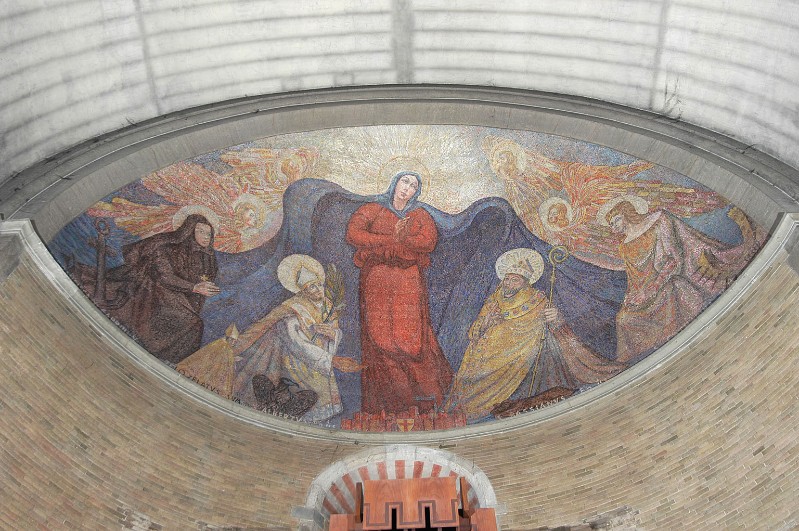by Elena Bulzi
Gold, blue, red. These are the chromatic notes that dominate the mosaic of the Assumption of Mary created by Aligi Sassu in 1964, in the apse basin of the Lodi Cathedral. The red, for example, is not a purple, the expensive color of the upper classes, a sign of power, but it is madder red, less shining, made from a grass that is easily available and therefore exploited by the less well-off. This choice of color prevents our imagination from fossilizing on undue sedimentation: it tells us at once that Mary did not belong to the category of the powerful of the time!
The identical red then unites Mary’s robe with the city of Lodi, from which she does not seem to want to detach herself: it expresses that solidarity with her people, with her environment, with the whole world, which she has never failed to show.
Looking at the mosaic, one then sees her in an unnatural position, seemingly made possible only by a mysterious force lifting her up, almost two invisible faces swelling the blue of her mantle. Contrary to what we are accustomed to thinking however, it was only in the Middle Ages that blue was allowed to enter the palette of colors accepted in churches, because, writes Michel Pastoureau, the world’s leading specialist on colors and their symbolic meanings – ‘a profound change in religious ideas takes place: the God of Christians becomes a God of Light. And the light is … blue! The Virgin then becomes the main agent of the promotion of blue’. Then those two faces can express the power of God the Father and God the Son enlivening history, albeit in the absolute discretion of those waiting for a ‘yes,’ like Mary’s, to act in the folds of the world. Those faces can then take on the appearance of that cloud of witnesses who over the centuries have given body, heart and mind to God’s action and who appear to us in the gold of the mosaic. I really do not believe, however, that this is the gold we too often want to hoard, thereby amplifying the gap of injustice between those who have a lot of it and those who have none at all. This is certainly not the gold of the one who rejoiced as Mary sang in the Magnificat, “He has overthrown the mighty from their thrones, He has raised up the humble, He has filled the hungry with good things, He has sent the rich away empty-handed.” Once again, internal references within the mosaic saves us from arbitrary overlaps: the same gold color indeed covers St. Catherine of Alexandria, a martyr from the first centuries of Christianity and placed to the left of Mary. Tradition reports of a young woman determined in her uncomfortable Christian choice and capable of not giving in to the enticements in which generations of women have been ensnared: prestigious marriage and wealth. This young martyr paid with her life for
her freedom of choice. The gold background then appears in our mosaic as a kind of cloth that does not cover the entire bowl of the apse, but allows glimpses of the same blue as the mantle: the sky and the sea of the world. Once again, the choice of color helps us to see the unceasing dialogue between God and his friends, including St. Frances Cabrini, the third woman who appears, a friend of Mary and placed at her right hand. She too was a great woman of the frontier, capable of choices that were by no means taken for granted.
It is only these three women who inhabit a liminal space, between the lower and upper registers of the mosaic: bodies firmly planted on the ground and heads that sweep over the margins in which one would like to lock their femininity. They are women of the threshold, attentive to what is happening in the history in which they live, and equally attentive to the whispering of God in it. The mosaic tiles render well the multifaceted figure of Mary, a friend of God and of women and men, a woman of intense joys and sorrows, a woman of history and of the Spirit, ‘an active participant in the divine work to heal the world’, a woman ‘whose style and the spirit of whose responses reverberate through the centuries to encourage the practice of discipleship in today’s diverse cultural contexts’ (Elisabeth Johnson), with all the unprecedented challenges it poses.
Mary’s Assumption is then not to be understood so much as an exclusive privilege, aimed at separating her from the rest of humanity, but as the fulfillment of a life lived in the joyful and strenuous journey of faith, as a traveling companion of all the sisters and brothers who, like her, have chosen and continue to choose to travel it.
The Assumption is the starting bell of a life that has already begun for her and that also awaits all of us. ■

